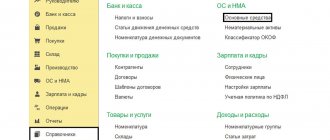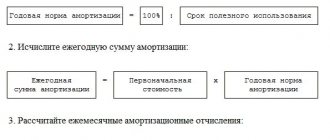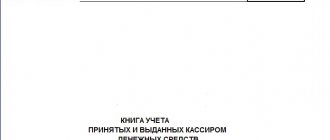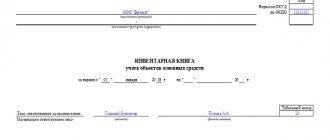In small enterprises, an inventory book in the OS-6b form is used to account for fixed assets and reflect their movement. It is filled in with information by the employee who is appointed responsible for accounting for fixed assets in the company. We will tell you how to fill out this document correctly.
- Form and sample
- Free download
- Online viewing
- Expert tested
FILES
Fixed assets in accounting
According to PBU 6/01, fixed assets DO NOT INCLUDE:
- Finished products;
- Goods;
- Items handed over for installation or to be installed;
- Capital investments;
- Financial investments;
- Items with a value below the established limit. Each organization determines it independently, but according to the law it cannot be higher than 40,000 rubles.
Fixed assets are assets intended for the production of products, performance of work, provision of services, as well as for management needs and provision for a fee for temporary possession and use. These assets are used for more than 12 months, are not intended for resale and are capable of generating income in the future (clause 4 of PBU 6/01).
Non-production objects with a service life of more than 12 months and a cost exceeding the limit on the value of fixed assets are also reflected in fixed assets, despite the fact that they do not meet the criteria of clause 4 of PBU 6/01.
A complete list of fixed assets is contained in the All-Russian Classifier of Fixed Assets (OKOF), approved by Decree of the State Standard of Russia dated December 26, 1994 No. 359.
Fixed assets and capital investments. New accounting standards
(Order of the Ministry of Finance of the Russian Federation dated September 17, 2020 No. 204n “On approval of Federal Accounting Standards FSBU 6/2020 “Fixed Assets” and FSBU 26/2020 “Capital Investments”, registered with the Ministry of Justice of the Russian Federation on October 15, 2020 No. 60399)
Effective from October 27, 2021:
– Federal Accounting Standard FSBU 6/2020 “Fixed Assets” ;
– Federal Accounting Standard FSBU 26/2020 “Capital Investments” .
Federal accounting standards FSBU 6/2020 “Fixed Assets” and FSBU 26/2020 “Capital Investments” are applied starting with the accounting (financial) statements for 2022 .
In this case, the organization may decide to apply the Standards before the specified deadline .
FSBU 6/2020 “Fixed assets”
The Ministry of Finance of the Russian Federation in the Information message dated November 3, 2020 No. IS-accounting-29 announced that the Standard replaces PBU 6/01 “Accounting for fixed assets” , approved by order of the Ministry of Finance of the Russian Federation dated March 30, 2001 No. 26n.
In connection with the adoption of this standard, from January 1, 2022, the Guidelines for accounting of fixed assets , approved by order of the Ministry of Finance of the Russian Federation dated October 13, 2003 No. 91n.
A number of new concepts have been introduced
The standard introduced certain new concepts and normatively established a number of concepts traditionally used in practice.
Among them:
a) book value - the original cost of the object, reduced by the amount of accumulated depreciation and impairment ( previously , the definition was not formulated );
b) group of fixed assets - a set of fixed assets of the same type, combined based on the similar nature of their use ( previously , the definition was not formulated );
c) investment real estate - real estate intended to be provided for a fee for temporary use and (or) to receive income from an increase in its value ( previously there was no concept of investment real estate; fixed assets intended exclusively for provision for a fee for temporary possession and use or for temporary use for the purpose of generating income were reflected as part of profitable investments in material assets).
In connection with the introduction of the concept of “investment real estate”, the concept of “profitable investments in material assets” is not used in relation to fixed assets ;
d) liquidation value - the amount that the organization would receive in the event of disposal of an item of fixed assets (including the value of material assets remaining from disposal) after deducting the estimated costs of disposal; Moreover, the fixed asset item is considered as if it had already reached the end of its useful life and was in a state characteristic of the end of its useful life ( previously , the concept was not used );
e) elements of depreciation - the useful life of an item of fixed assets, its liquidation value and the method of calculating depreciation ( previously , the concept was not used );
f) revalued value - the value of a fixed asset after its revaluation ( previously - the current ( replacement ) value );
g) impairment - the condition of an asset in which its book value exceeds the amount that can be received from using the asset or as a result of its sale ( previously - the concept was not used ).
Objects of fixed assets have been specified
The characteristics characterizing fixed assets have been clarified .
In the standard these include :
– the presence of a material form ( previously not formulated );
– intended for use by an organization in the normal course of its activities in the production and (or) sale of its products (goods), when performing work or providing services, for environmental protection , for provision for temporary use for a fee, for management needs, or for use in activities of a non-profit organization aimed at achieving the goals for which it was created ( previously there was no indication of the possibility of use for environmental protection );
– intended for use by the organization for a period of more than 12 months or a normal operating cycle exceeding 12 months ( previously it also contained an indication that the organization does not intend to resell the item );
– is capable of bringing economic benefits to the organization in the future (to ensure that the non-profit organization the goals for which it was created).
Long-term assets for sale are excluded from the scope of application of FAS 6/2020 (previously they were taken into account as part of fixed assets ).
Since 2021, this type of assets has been accounted for in accordance with PBU 16/02 “Information on discontinued activities” , approved by order of the Ministry of Finance of the Russian Federation dated July 2, 2002 No. 66n.
As part of fixed assets, investment real estate objects are separately accounted for and reflected in the financial statements .
The procedure for accounting for low-value items has been changed
The standard establishes a general approach to determining low-value assets that have characteristics of fixed assets , but which may not be accounted for as fixed assets: objects are considered for accounting purposes as low-value based on the materiality of information about them ( previously , the cost of such assets did not exceed 40,000 rubles per unit ).
Based on this approach, the organization independently sets a limit on the value of low-value assets .
Costs for the acquisition and creation of such assets are recognized as expenses of the period in which they were incurred (previously, these assets were reflected as part of inventories).
At the same time, the organization is obliged to ensure proper control of their availability and movement.
The procedure for determining inventory objects has been clarified
The traditional approach to determining inventory items of fixed assets is supplemented by recognition as an independent inventory item :
– each part of one fixed asset item, the cost and useful life differ significantly from the cost and useful life of the object as a whole ( previously - with a significant difference only in the useful life );
– significant expenses of the organization for repairs fixed assets with a frequency of more than 12 months or more than the usual operating cycle exceeding 12 months ( previously included in period expenses ).
Depreciation rules changed
The main innovations in matters of depreciation of fixed assets:
1) non-profit organizations accrue depreciation of fixed assets in the general manner ( previously , depreciation was not accrued, but depreciation amounts were accrued in off-balance sheet accounting );
2) depreciation calculation:
a) begins from the moment the object is recognized in accounting and ends from the moment it is written off from accounting ( previously , depreciation began on the first day of the month following the month the object was recognized in accounting, and stopped on the first day of the month following the month of write-off object from accounting).
The previously used approach to determining the point at which depreciation is also acceptable ;
b) is not suspended in cases of downtime or temporary cessation of use of fixed assets ( previously it was suspended when an object was mothballed for a period of more than three months , as well as for the period of restoration of an object, the duration of which exceeded 12 months);
c) suspended in the event that the liquidation value of the object becomes equal to or exceeds its book value.
If subsequently the liquidation value of such an object becomes less than its book value , depreciation on it is resumed ( previously , depreciation on an object was carried out until its cost was fully paid off or it was written off from accounting);
3) have been established for the method of depreciation of fixed assets chosen by the organization ( previously , no requirements were formulated ).
The chosen depreciation method should:
a) most accurately reflect the distribution over time of expected future economic benefits from the use of a group of fixed assets;
b) be applied consistently from one reporting period to another, except in cases where the distribution over time of expected future economic benefits from the use of a group of fixed assets changes;
4) when applying the reducing balance method of depreciation , the organization independently determines the formula for calculating the amount of depreciation for the reporting period.
In this case , the formula should ensure a systematic reduction of this amount as the useful life of this object expires ( previously , the annual depreciation amount was determined based on the residual value of the object at the beginning of the reporting year and the depreciation rate calculated based on the useful life of this object and the coefficient established by the organization in a size not exceeding 3);
5) for the depreciation method in proportion to the quantity of products (volume of work in kind), a ban has been introduced on determining the amount of depreciation for the reporting period based on the amount of receipts (revenue or other similar indicator) from the sale of products (work, services) produced (performed, provided) using of this fixed asset ( previously the prohibition was not formulated ).
6) elements of depreciation of a fixed asset object are subject to verification for compliance with the conditions of use of this object.
Such a check is carried out at the end of each reporting year , as well as upon the occurrence of circumstances indicating a possible change in the elements of depreciation.
Based on the results of the inspection, if necessary, a decision is made to change the relevant elements of depreciation ( previously , the method of calculating depreciation and the useful life, as a rule, were not subject to change );
7) the basis for calculating the amount of depreciation for the reporting period has been changed: such an amount is calculated on the basis of the book value of the fixed asset, remaining useful life , adjusted liquidation value ( previously - based on the original cost of the fixed asset and the total useful life );
 the amount of depreciation of an object of fixed assets for the reporting period is determined in such a way that by the end of the depreciation period the book value of this object becomes equal to its liquidation value ( previously equal to zero ).
the amount of depreciation of an object of fixed assets for the reporting period is determined in such a way that by the end of the depreciation period the book value of this object becomes equal to its liquidation value ( previously equal to zero ).
Revaluation rules changed
After recognition, an item of fixed assets can be reflected in accounting at a revalued cost .
At the same time, the value of such an object regularly revalued so that it is equal to or does not differ significantly from its fair value ( previously , the object was revalued at its current (replacement) cost).
Fair value is determined in the manner prescribed by International Financial Reporting Standard ( IFRS ) 13 “Fair value measurement” , put into effect on the territory of the Russian Federation by Order of the Ministry of Finance of the Russian Federation dated December 28, 2015 No. 217n.
All organizations have the right to revaluate fixed assets ( previously only commercial organizations).
Revaluation is carried out as the fair value of fixed assets changes ( previously - no more than once a year at the end of the reporting period).
At the same time, it is permissible to decide to conduct a revaluation no more than once a year (as of the end of the reporting year).
When carrying out a revaluation, along with a proportional recalculation of the original cost and accumulated depreciation of an item of fixed assets, it is also acceptable to use a method in which first the initial cost of an item of fixed assets is reduced by the amount of depreciation accumulated on it on the date of revaluation, and then the resulting amount is recalculated in such a way that it became equal to the fair value of this object ( previously - only proportional recalculation).
The amount of accumulated revaluation can be written off to the organization’s retained earnings in one of two ways : at a time when writing off an overvalued fixed asset item or as depreciation is calculated on such an object ( previously - only at a time when writing off a fixed asset item).
Revaluation of investment real estate is carried out in a manner different from the procedure for revaluation of other fixed assets.
Main differences:
a) revaluation is carried out at each reporting date ;
b) the initial cost of the object (including previously revalued) is recalculated so that it becomes equal to its fair value ;
c) revaluation or depreciation of an object is included in the financial result of the organization’s activities as income or expense of the period in which the revaluation of this object was carried out;
d) revalued objects are not subject to depreciation.
An organization that decides to value investment property at a revalued value must use this valuation method for all investment properties.
Impairment introduced
Mandatory testing of fixed assets for impairment and accounting for changes in their book value due to impairment have been introduced.
These checks and records are carried out in the manner prescribed by IAS 36 “Impairment of Assets” , put into effect on the territory of the Russian Federation by Order of the Ministry of Finance of the Russian Federation dated December 28, 2015 No. 217n .
The composition of the information disclosed in the reporting has been clarified
The list of information about fixed assets disclosed in the financial statements is supplemented with data on :
a) the book value of investment property at the beginning and end of the reporting period;
b) the result of disposal of fixed assets for the reporting period;
c) the result of the revaluation of fixed assets included in the income or expenses of the reporting period, capital in the reporting period;
d) the result of impairment of fixed assets and reversal of impairment included in expenses or income of the reporting period; the amount of impairment of fixed assets allocated in the reporting period to reduce the accumulated result of revaluation; other information on impairment of fixed assets provided for by IAS 36 “Impairment of Assets”;
e) the book value of suitable but not used fixed assets, when this is not related to the seasonal characteristics of the organization’s activities, as of the reporting date;
f) the book value of fixed assets in respect of which there are restrictions on the organization’s property rights , including fixed assets that are pledged, as of the reporting date;
g) methods of assessing fixed assets (by groups);
h) elements of depreciation of fixed assets and their changes ( previously - only about the useful life and methods of calculating depreciation);
i) recognized as income in profit (loss) is the amount of compensation for losses associated with the depreciation or loss of fixed assets provided to the organization by other persons.
In relation to fixed assets valued at revalued amounts, a number of additional information disclosure requirements have been established, in particular:
– date of the last revaluation of fixed assets;
– information about engaging an independent appraiser;
– methods and assumptions adopted in determining the fair value of property, plant and equipment, including information on the use of observable market prices;
– the book value of the revalued groups of fixed assets, which would be reflected in the financial statements if they were assessed at their historical cost, as of the reporting date;
– methods for recalculating the initial cost of revalued groups of fixed assets;
– the amount of accumulated revaluation of fixed assets not written off to retained earnings, indicating the method of writing off the accumulated revaluation to retained earnings.
A number of other rules have been clarified
FSBU 6/2020 clarified a number of accounting rules for fixed assets :
a) a prospective reflection of the consequences of changes in the method of valuing fixed assets is provided , that is, without recalculating data for previous periods ( previously this was not provided);
b) the procedure for reflecting changes in the amount of the estimated liability for future dismantling, disposal of fixed assets and restoration of the environment, taken into account in the initial cost of this object, has been changed.
A change in this amount ( without taking into account interest ) increases or decreases the initial cost of the object .
Moreover, if an object is accounted for at a revalued value revaluation of it (if any) is adjusted by the amount of the change in its original value; the amount of such an adjustment is included in the aggregate financial result without being included in profit or loss (previously, a change in the amount of the estimated liability was attributed to the financial result of the period and did not change the initial cost and the result of the revaluation of the fixed asset);
c) the list of cases of disposal of fixed assets and its inability to bring economic benefits to the organization in the future is supplemented with such cases as :
– expiration of the normatively permissible periods or other maximum parameters for its operation , as a result of which its use by the organization becomes impossible ;
– termination by the organization of the activity in which this object was used, in the absence of the possibility of its use in ongoing activities; transfer to non-operating (financial) lease;
– transfer to a non-profit organization ( previously not formulated).
Simplified methods of accounting for fixed assets
Organizations that, in accordance with the legislation of the Russian Federation, have the right to use simplified methods of accounting, can :
a) not apply the procedure for adjusting the initial cost of a fixed asset in connection with a change in the amount of the estimated liability for future dismantling, disposal of the fixed asset item and environmental restoration provided for by the standard;
b) refuse to test fixed assets for impairment , that is, evaluate fixed assets at their book value as of the reporting date;
c) disclose information about fixed assets in the financial statements to a limited extent .
Transitional provisions
The consequences of changes in the accounting policies of an organization in connection with the start of application of FAS 6/2020 are reflected retrospectively , that is, as if this standard had been applied from the moment the facts of economic life affected by it arose.
To facilitate the transition to a new procedure for accounting for fixed assets in financial statements , starting from which FAS 6/2020 is applied, the organization may not recalculate comparative indicators related to fixed assets for periods preceding the reporting one, making a one-time adjustment to the book value of fixed assets at the beginning of the reporting period ( end of the period preceding the reporting period).
For the purposes of this adjustment, the carrying amount of fixed assets is considered to be their original cost (including revaluations), recognized before the application of FAS 6/2020 in accordance with the previously applied accounting policy, less accumulated depreciation.
In this case, accumulated depreciation is calculated in accordance with FAS 6/2020 based on the specified initial cost, liquidation value and the ratio of the expired and remaining useful life, determined in accordance with FAS 6/2020.
The method chosen by the organization to reflect the consequences of changes in accounting policies is disclosed in the first financial statements prepared using FAS 6/2020.
(Read about the new procedure for accounting for capital investments in issue 34 of AB-Express.)
Limit on the value of fixed assets
If a fixed asset costs less than the fixed asset cost limit established in the organization’s accounting policy, then it can be reflected as part of inventories. The cost limit cannot be higher than 40,000 rubles (clause 5 of PBU 6/01).
In order to ensure the safety of these objects in production or during operation, the organization must organize proper control over their movement.
In tax accounting, the limit on the value of fixed assets is fixed; from January 1, 2021, it is equal to 100 thousand rubles. Previously, as in accounting, it was 40 thousand rubles.
The higher the limit on the value of fixed assets, that is, the fewer fixed assets on the balance sheet, the more profitable the organization:
- expenses are written off immediately, rather than stretched out over years (depreciation);
- Pay less property tax.
The limit on the value of fixed assets in accounting is established by accounting policy.
Acceptance of the object for registration during construction
The general requirements for accepting for accounting objects that are not purchased in a “finished” form, but are being built, are generally similar.
At the same time, during capital construction there is a significant feature established by Art. 55 of the Town Planning Code of the Russian Federation. The fact is that the document confirming the creation of a real estate property is a permit to put it into operation. Consequently, until such permission is received, the object built by the organization (or for it) cannot be used; it is not suitable for use.
Moreover, even after receiving permission to put the facility into operation, the facility may require additions and improvements. In this case, it continues to be included in investments in non-current assets until all work is completed to bring it into a state suitable for use and the initial value is formed.
This conclusion was made, for example, in the decision of the Arbitration Court of the Moscow District dated November 16, 2016 in case No. A40-26076/2016.
At the same time, we will make a reservation that if permission to put an object into operation is not obtained only formally, but in fact the object is already suitable for use or even in use, it must be taken into account as part of the operating system. This is indicated by the requirement of priority of content over form, that is, the requirement to reflect in accounting the facts of economic activity based not so much on their legal form, but on their economic content and business conditions (clause 6 of PBU 1/2008 “Accounting Policy of the Organization”, approved Order of the Ministry of Finance of Russia dated October 6, 2008 No. 106n).
But state registration of ownership (or other right) to real estate does not matter in this case, since PBU 6/01 does not establish such a condition (see paragraph 2 of the Review of the practice of resolving cases by arbitration courts related to the application of certain provisions of Chapter 30 Tax Code of the Russian Federation, appendices to the information letter of the Presidium of the Supreme Arbitration Court of the Russian Federation dated November 17, 2011 No. 148). In tax accounting, this circumstance also does not matter (clause 4 of Article 259 of the Tax Code of the Russian Federation).
Useful life
The period during which the use of an item of fixed assets brings economic benefits (income) to the organization is called its useful life (USL).
For certain groups of fixed assets, the useful life is determined based on the quantity of products (volume of work in physical terms) expected to be received as a result of the use of this object.
The main assets include:
- buildings, structures,
- working and power machines and equipment,
- measuring and control instruments and devices,
- Computer Engineering,
- vehicles,
- tools, production and household equipment and supplies,
- working, productive and breeding livestock,
- perennial plantings,
- on-farm roads and other relevant facilities,
- capital investments for radical improvement of land (drainage, irrigation and other reclamation works);
- capital investments in leased fixed assets;
- land,
- environmental management objects (water, subsoil and other natural resources).
Land plots not intended for sale, regardless of their value (for example, less than 40 thousand rubles) are classified as fixed assets, since they cannot be classified as inventories.
Capital investments
When to apply the standard
First of all, you need to pay attention to the fact that PBU 6/01 does not regulate capital investment issues. Thus, FSBU 26/2020 sets the rules and does not change them.
The standard establishes requirements for the formation of information on capital investments in accounting. Capital investments are the costs of acquiring, creating, improving or restoring an operating system. Examples of such costs are given by FSBU 26/2020. These include construction costs, radical land improvement, preparation of design documentation, commissioning and testing. Note that the standard does not apply if the entity performs work or services for others or acquires or creates assets for sale.
How capital investments are valued and recognized
To recognize capital investments in accounting, the following conditions must be simultaneously met:
- the costs will provide future economic benefits over a period of more than 12 months or a normal operating cycle of more than 12 months;
- the amount of expenses incurred or an amount equivalent to it is determined.
The unit of accounting for capital investments is the acquired, created, improved or restored asset.
Capital investments are recognized in the amount of actual costs . Costs are considered to be the disposal or reduction of an organization's assets or the occurrence or increase of its liabilities that are associated with capital investments. In this case, the costs do not include prepayment until the seller or supplier fulfills its contractual obligations.
Capital investments must be recognized as actual costs are incurred for which the recognition conditions are met. FSBU 26/2020 establishes an open list of expenses that are included in the amount of actual costs. These are, for example, the following expenses:
- the cost of assets that are written off when making capital investments;
- employee salaries;
- interest that must be included in the cost of an investment asset.
Expenses are included in capital investments less any refundable taxes and fees, and also taking into account all discounts, rebates, deductions, bonuses and incentives, regardless of the form in which they are provided.
Certain provisions of FSBU 26/2020 regulate situations when:
- expenses are incurred deferred or in installments;
- the contract for capital investments provides for non-monetary fulfillment of obligations;
- the organization received the property free of charge;
- When making capital investments, the organization receives products, secondary raw materials or materials that it intends to sell or use in some way.
In addition, there is a list of costs that are not included in capital investments, for example:
- expenses that the organization incurred before deciding to acquire, create, improve or restore the operating system;
- costs of unscheduled repairs of operating systems, when such work restores the performance indicators of objects, but does not improve them or extend their service life;
- expenses for advertising and product promotion;
- personnel training costs.
When is capital investment derecognised?
Once an investment has been made ready for use and placed where it is needed, the investment becomes an asset. If the operation of a part of the facility actually begins before the completion of capital investments, then this part is recognized as the main asset.
An entity may write off capital investments that are retired or are unable to produce future economic benefits. Possible reasons for such a write-off are given by FSBU 26/2020. For example, this is the loss of property due to an accident or the cessation of capital investments due to the fact that there are no prospects for selling an unfinished facility.
Inventory object
The accounting unit for fixed assets is an inventory item.
An inventory object is an object with all fixtures and accessories, or a separate structurally isolated object, intended to perform certain independent functions, or a separate complex of structurally articulated objects, representing a single whole and intended to perform a specific job.
For example, an organization has several safes of the same model, color, and year of manufacture. Each safe is an inventory object that is assigned an inventory number. It should be reflected in accounting separately from other safes.
A complex of structurally articulated objects is one or more objects of the same or different purposes, having common devices and accessories, common control, mounted on the same foundation, as a result of which each object included in the complex can perform its functions only as part of the complex, and not independently.
If one object has several parts, the useful lives of which differ significantly, each such part is accounted for as an independent inventory item.
For example, a computer is a complex of objects: system unit, monitor, mouse, keyboard. Individually, these items are useless, but together they form one fixed asset item.
How an inventory of fixed assets is carried out: main stages and necessary accounting documents
The procedure for inventorying fixed assets is established by the head of the company in accordance with current legislation.
There are 3 main stages of inventory:
1. The organization must create an inventory commission, the composition of which is approved by the head of the company in the order to conduct an inventory in the INV-22 form .
You can find a sample order in form INV-22 in ConsultantPlus. Get trial access to the system for free and proceed to the example of this document.
The inventory commission should include accountants, OS specialists, and company management. The absence of at least one member of the commission is unacceptable - only with 100% attendance of all inventory participants, the procedure is considered successful. In addition to the composition of the commission, INV-22 records the timing of the inventory, reasons and objects of inspection.
ATTENTION! There are no restrictions on the maximum and minimum number of commission members under current legislation. But if at least one member of the commission is not present during the inventory, then all inspection results will be considered invalid.
All inventories carried out by the company must be recorded in a journal using the INV-23 form .
Before starting the inventory, members of the commission receive current documents on the company's operating system. They are marked “before inventory on ____ (date).” Financially responsible persons confirm in writing that by the beginning of the procedure all documents on the OS were transferred to the commission.
In addition to accounting documents on OS, the commission checks:
- information that confirms the company’s ownership of buildings;
- technical passports and other technical documentation;
- analytical accounting registers;
- availability of documents for natural resource objects owned by the company.
2. During the inventory, the commission examines the OS and records in the inventory in the INV-1 form the name of the OS, purpose, inventory numbers and main indicators of the object.
For vehicles and equipment, the inventory must indicate the serial number in accordance with the manufacturer's technical passport, year of manufacture, purpose, power.
OSes of the same type, which arrived at the organization at the same time and are recorded on the group accounting inventory card, are indicated in the inventory by name with an indication of quantity.
A sample inventory in the INV-1 form can be viewed and downloaded in ConsultantPlus, having received trial access to the system for free.
Assets that are not in the company at the time of inventory (except for those leased), for example, a ship or train has been sent on a voyage, are checked until their temporary absence.
3. Discrepancies between actual and accounting data are identified. Discrepancies between accounting data and the actual state of the fixed assets recorded in INV-1 are reflected in the matching statement in the INV-18 form .
The statement is drawn up in 2 copies: one for the accounting department, the second for the financially responsible persons, and the commission requests from them written explanations of the reasons for the discrepancies.
A sample matching statement in form INV-18 can be viewed and downloaded in ConsultantPlus, having received trial access to the system for free.
Purposes of fixed asset accounting
The main goals of accounting for fixed assets are (clause 6 of Order of the Ministry of Finance of the Russian Federation dated October 13, 2003 N 91n “On approval of Guidelines for accounting of fixed assets”):
a) formation of actual costs associated with the acceptance of assets as fixed assets for accounting;
b) correct execution of documents and timely reflection of the receipt of fixed assets, their internal movement and disposal;
c) reliable determination of the results from the sale and other disposal of fixed assets;
d) determination of actual costs associated with the maintenance of fixed assets (technical inspection, maintenance, etc.);
e) ensuring control over the safety of fixed assets accepted for accounting;
f) analysis of the use of fixed assets;
g) obtaining information about fixed assets necessary for disclosure in the financial statements.
Inventory of real estate: procedure
The inventory of real estate (land plots, buildings, structures, other objects firmly connected to the land, aircraft, sea and river vessels), recorded as part of fixed assets, is generally carried out in the same way as the inventory of other fixed assets, but taking into account some features.
Among other things, when making an inventory of real estate, check the availability of documents (certificates of state registration of ownership, etc.) confirming ownership of these objects (clause 3.2 of the Inventory Guidelines). Make sure that the details of the document confirming ownership are indicated in the property's inventory card.
Additionally, check and indicate in the inventories the main characteristics of real estate, for example (clause 3.3 of the Inventory Guidelines):
• for buildings - their purpose, the main materials from which they are built, volume (according to external or internal measurements), area (total usable area), number of floors (excluding basements, semi-basements, etc.), year of construction;
• along canals - length, depth and width (along the bottom and surface), artificial structures, materials for fastening the bottom and slopes;
• for bridges - location, type of materials and main dimensions;
• on roads - type of road (highway, profiled), length, covering materials, width of the road surface;
• for land in agricultural organizations - the book value and the amount of accrued depreciation on capital investments for radical improvement of land, as well as the location of land plots and to whom they are assigned (department, team, other structural unit) (clause 34 of the Methodological Recommendations for Accounting investments made in the form of capital investments in agricultural organizations).
Depreciation and wear
Fixed assets can be received by the organization:
- under a purchase and sale agreement;
- free of charge;
- as a contribution to the authorized capital;
- by barter (under an exchange agreement);
- as a result of construction (manufacturing) by contract and economic methods;
- in the form of surpluses identified during inventory.
Repay the cost of fixed assets by calculating depreciation. Depreciation is accrued for fixed assets of non-profit organizations. This procedure is provided for in paragraph 17 of PBU 6/01 for fixed assets that are depreciable property.








